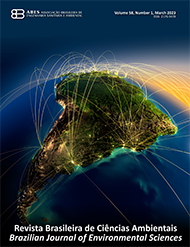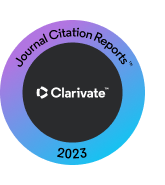Bioconversion of orange pomace using Hermetia illucens larvae: development and nutritional composition of the larvae
DOI:
https://doi.org/10.5327/Z2176-94781974Keywords:
agroindustrial residue; larval biomass; alternative protein; BSFL; animal feed.Abstract
Oranges, a popular fruit, generate large amounts of waste, with half discarded as pomace after juice extraction, contributing to 110–120 million tons of citrus waste annually, and posing environmental challenges, especially regarding soil and water pollution. Therefore, this study evaluates bioconversion using larvae of Hermetia illucens (BSFL) fed with orange pomace, analyzing the effectiveness of the process and the resulting larvae’s nutritional quality. Preliminary tests showed that pure orange pomace does not provide the necessary nutritional support for BSFL development. Thus, BSFL was fed with pomace supplemented with farinaceous at different concentrations: LA25 (25% pomace, 75% farinaceous residue), LA50 (50% pomace, 50% farinaceous residue), LA75 (75% pomace, 25% farinaceous residue), and LA0 (100% farinaceous residue). Larval performance, bioconversion development, and BSFL nutritional quality were evaluated. Results showed that BSFL can effectively convert orange pomace, utilize its nutrients, and reduce its pollutant potential. Overall, using only pure orange pomace did not support larval growth. However, increasing levels of farinaceous residue altered development, bioconversion parameters, and BSFL nutritional quality (p≤0.05). It was observed that 25% of the farinaceous residue (LA75) significantly improved BSFL’s overall performance (p≤0.05), also enhancing the valorization of this residue concerning all evaluated parameters.
Downloads
References
Adámková, A.; Mlček, J.; Adámek, M.; Borkovcová, M.; Bednářová, M.; Hlobilová, V.; Juríková, T., 2020. Tenebrio molitor (Coleoptera: Tenebrionidae) - Optimization of rearing conditions to obtain desired nutritional values. Journal of Insect Science, v. 20, (5), 24. https://doi.org/10.1093/jisesa/ieaa100
Association of Official Analytical Chemists (AOAC), 2016. Official Methods of Analysis of AOAC International. 20. ed. AOAC International, Rockville, Maryland.
Bosch, G.; Oonincx, D.G.A.B.; Jordan, H.R.; Zhang, J.; Van Loon, J.J.A.; Van Huis, A.; Tomberlin, J.K., 2020. Standardisation of quantitative resource conversion studies with black soldier fly larvae. Journal of Insects as Food and Feed, v. 6, (2), 95-109. https://doi.org/10.3920/JIFF2019.0004
Cammack, J.A.; Tomberlin, J.K., 2017. The impact of diet protein and carbohydrate on select life-history traits of the black soldier fly Hermetia illucens (L.) (Diptera: Stratiomyidae). Insects, v. 8, (2), 56. https://doi.org/10.3390/insects8020056
Chiam, Z.; Lee, J.T.E.; Tan, J.K.N.; Song, S.; Arora, S.; Tong, Y.W.; Tan, H T.W., 2021. Evaluating the potential of okara-derived black soldier fly larval frass as a soil amendment. Journal of Environmental Management, v. 286, 112163. https://doi.org/10.1016/j.jenvman.2021.112163
Cypriano, D.Z.; Da Silva, L.L.; Mariño, M.A.; Tasic, L., 2017. Orange biomass by-products. Revista Virtual de Química, v. 9, (1), 176-191. https://doi.org/10.21577/1984-6835.20170014
da Cruz, R.M.S.; da Silva, C.; da Silva, E.A.; Hegel, P.; Barão, C.E.; Cardozo-Filho, L., 2022. Composition and oxidative stability of oils extracted from Zophobas morio and Tenebrio molitor using pressurized n-propane. The Journal of Supercritical Fluids, v. 181, 105504. https://doi.org/10.1016/j.supflu.2021.105504
Dortmans, B.; Diener, S.; Bart, V.; Zurbrügg, C., 2017. Black soldier fly biowaste processing: a step-by-step guide. Eawag (Accessed September 24, 2023) at:. https://www.dora.lib4ri.ch/eawag /islandora/object/ eawag:15615
dos Santos, L.A.; Santos, A.F.F.; Valença, R.B.; Jucá, J.F.T.; Oliveira, C.R.M., 2018. Produção de biogás a partir de bagaço de laranja. Revista Geama, v. 4, (3), 22-27.
Ebeneezar, S.; Tejpal, C.S.; Jeena, N.S.; Summaya, R.; Chandrasekar, S.; Sayooj, P.; Vijayagopal, P., 2021. Nutritional evaluation, bioconversion performance and phylogenetic assessment of black soldier fly (Hermetia illucens, Linn. 1758) larvae valorized from food waste. Environmental Technology & Innovation, v. 23, 101783. https://doi.org/10.1016/j.eti.2021.101783
Hahn, T.; Roth, A.; Febel, E.; Fijalkowska, M.; Schmitt, E.; Arsiwalla, T.; Zibek, S., 2018. New methods for high‐accuracy insect chitin measurement. Journal of the Science of Food and Agriculture, v. 98, (13), 5069-5073. https://doi.org/10.1002/jsfa.9044
Jenkins, S.N.; Middleton, J.A.; Huang, Z.; Mickan, B.S.; Andersen, M.O.; Wheat, L.; Abbott, L.K., 2023. Combining frass and fatty acid co-products derived from Black soldier fly larvae farming shows potential as a slow release fertilizer. Science of the Total Environment, v. 899, 165371. https://doi.org/10.1016/j.scitotenv.2023.165371
Jeon, H.; Park, S.; Choi, J.; Jeong, G.; Lee, S.B.; Choi, Y.; Lee, S.J., 2011. The intestinal bacterial community in the food waste-reducing larvae of Hermetia illucens. Current Microbiology, v. 62, 1390-1399. https://doi.org/10.1007/s00284-011-9874-8
Komilus, C.F.; Mufit, N.M.M., 2021. Dried acetes as growth promoter for guppy (Poecilia reticulata) nutrition. IOP Conference Series: Earth and Environmental Science, v. 919, (1), 012049. https://doi.org/10.1088/1755-1315/919/1/012049
Lalander, C.; Diener, S.; Zurbrügg, C.; Vinnerås, B., 2019. Effects of feedstock on larval development and process efficiency in waste treatment with black soldier fly (Hermetia illucens). Journal of Cleaner Production, v. 208, 211-219. https://doi.org/10.1016/j.jclepro.2018.10.017
Lee, C.M.; Lee, Y.S.; Seo, S.H.; Yoon, S.H.; Kim, S.J.; Hahn, B.S.; Koo, B.S., 2014. Screening and characterization of a novel cellulase gene from the gut microflora of Hermetia illucens using metagenomic library. Journal of Microbiology and Biotechnology, v. 24, (9), 1196-1206. https://doi.org/10.4014/jmb.1405.05001
Lu, S.; Taethaisong, N.; Meethip, W.; Surakhunthod, J.; Sinpru, B.; Sroichak, T.; Paengkoum, P., 2022. Nutritional composition of black soldier fly larvae (Hermetia illucens L.) and its potential uses as alternative protein sources in animal diets: a review. Insects, v. 13, (9), 831. https://doi.org/10.3390/insects13090831
Mahato, N.; Sharma, K.; Sinha, M.; Baral, E.R.; Koteswararao, R.; Dhyani, A.; Hwan Cho, M.; Cho, S., 2020. 'Bio-sorbents, industrially important chemicals and novel materials from citrus processing waste as a sustainable and renewable bioresource: a review. Journal of Advanced Research, v. 23, 61-82. https://doi.org/10.1016/j.jare.2020.01.007
Nowak, V.; Persijn, D.; Rittenschober, D.; Charrondiere, U.R., 2016. Review of food composition data for edible insects. Food Chemistry, v. 193, 39-46. https://doi.org/10.1016/j.foodchem.2014.10.114
Parodi, A.; De Boer, I.J.; Gerrits, W.J.; Van Loon, J.J.; Heetkamp, M.J.; Van Schelt, J.; Van Zanten, H.H., 2020. Bioconversion efficiencies, greenhouse gas and ammonia emissions during black soldier fly rearing–A mass balance approach. Journal of Cleaner Production, v. 271, 122488. https://doi.org/10.1016/j.jclepro.2020.122488
Singh, A.; Kumari, K., 2019. An inclusive approach for organic waste treatment and valorization using Black Soldier Fly larvae: A review. Journal of Environmental Management, v. 251, 109569. https://doi.org/10.1016/j.jenvman.2019.109569
Terfa, G.N., 2021. Role of black soldier fly (Hermetia illucens) larvae frass bio-fertilizer on vegetable growth and sustainable farming in Sub-Saharan Africa. Reviews in Agricultural Science, v. 9, 92-102. https://doi.org/10.7831/ras.9.0_92
Wang, Y.S.; Shelomi, M., 2017. Review of black soldier fly (Hermetia illucens) as animal feed and human food. Foods, v. 6, (10), 91. https://doi.org/10.3390/foods6100091
Wu, R.A.; Ding, Q.; Yin, L.; Chi, X.; Sun, N., He, R.; Li, Z., 2020. Comparison of the nutritional value of mysore thorn borer (Anoplophora chinensis) and mealworm larva (Tenebrio molitor): Amino acid, fatty acid, and element profiles. Food Chemistry, v. 323, 126818. https://doi.org/10.1016/j.foodchem.2020.126818
Zema, D.A.; Calabrò, P.S.; Folino, A.; Tamburino, V.; Zappia, G.; Zimbone, S.M., 2018. Valorization of citrus processing waste: a review. Waste Management, v. 80, 252-273. https://doi.org/10.1016/j.wasman.2018.09.024
Published
How to Cite
Issue
Section
License
Copyright (c) 2024 Revista Brasileira de Ciências Ambientais (RBCIAMB)

This work is licensed under a Creative Commons Attribution 4.0 International License.


























